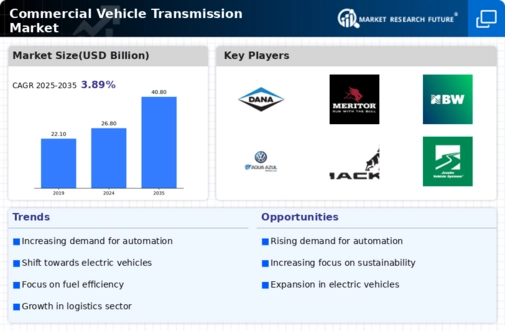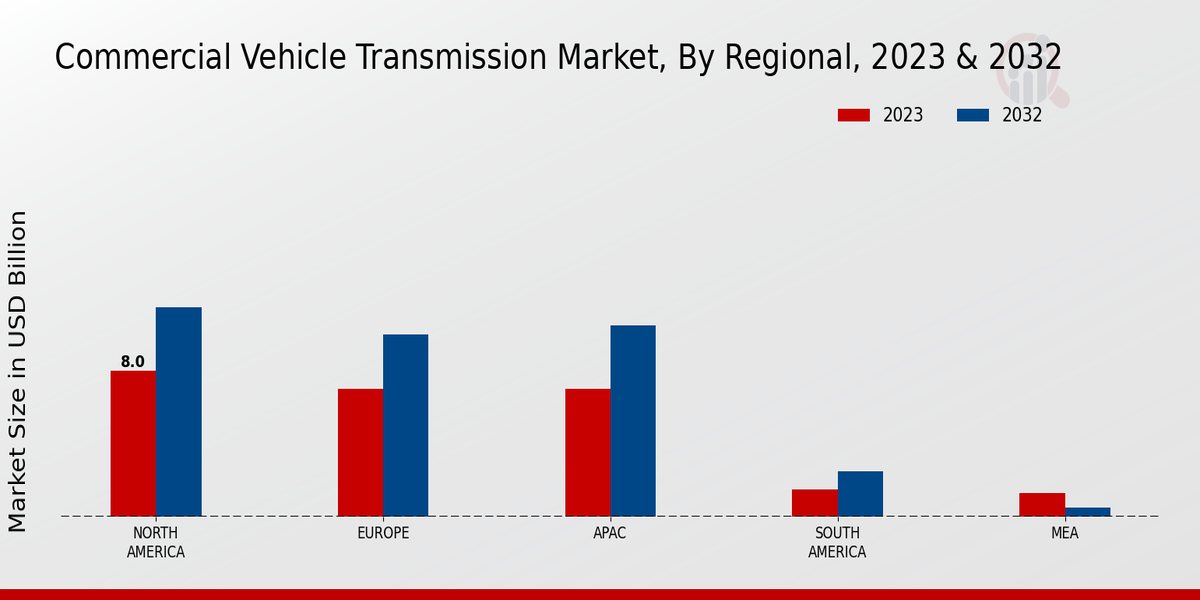Market Growth Projections
The Global Commercial Vehicle Transmission Market Industry is poised for substantial growth, with projections indicating a compound annual growth rate (CAGR) of 3.89% from 2025 to 2035. This growth trajectory is underpinned by various factors, including technological advancements, regulatory pressures, and the evolving needs of the logistics sector. As the market expands, it is anticipated that manufacturers will increasingly focus on developing innovative transmission solutions that cater to the demands of modern commercial vehicles. This growth not only reflects the resilience of the industry but also highlights the potential for new entrants and innovations in the market.
Stringent Emission Regulations
The Global Commercial Vehicle Transmission Market Industry is significantly influenced by stringent emission regulations imposed by governments worldwide. These regulations aim to reduce greenhouse gas emissions and promote cleaner transportation alternatives. As a result, manufacturers are compelled to develop transmission systems that comply with these standards, often leading to the adoption of more efficient technologies. The shift towards electric and hybrid commercial vehicles is also gaining momentum, further driving the need for innovative transmission solutions. This regulatory landscape is likely to shape market dynamics, pushing companies to invest in sustainable practices and technologies.
Technological Advancements in Transmission Systems
Technological innovations play a pivotal role in shaping the Global Commercial Vehicle Transmission Market Industry. The integration of automated and semi-automated transmission systems is becoming increasingly prevalent, offering enhanced driving comfort and operational efficiency. These advancements not only improve vehicle performance but also contribute to safety by reducing the likelihood of human error. Manufacturers are investing in research and development to create smarter transmission solutions that can adapt to varying driving conditions. This trend is expected to propel the market forward, as companies recognize the competitive advantage of adopting cutting-edge technology in their fleets.
Increasing Investment in Infrastructure Development
Investment in infrastructure development is a key driver for the Global Commercial Vehicle Transmission Market Industry. Governments across various regions are allocating substantial funds to enhance transportation networks, which directly benefits the commercial vehicle sector. Improved road conditions and expanded logistics hubs facilitate smoother operations for commercial vehicles, necessitating advanced transmission systems that can handle diverse driving conditions. This trend is expected to stimulate market growth, as the demand for reliable and efficient transportation solutions continues to rise in tandem with infrastructure improvements.
Growth of E-commerce and Last-Mile Delivery Services
The rise of e-commerce has transformed the logistics landscape, thereby impacting the Global Commercial Vehicle Transmission Market Industry. With the increasing demand for last-mile delivery services, there is a growing need for commercial vehicles that can navigate urban environments efficiently. This trend necessitates the development of transmission systems that enhance maneuverability and fuel efficiency. As the market evolves, it is projected to reach 40.8 USD Billion by 2035, reflecting the critical role that advanced transmission technologies will play in meeting the demands of a rapidly changing delivery ecosystem.
Rising Demand for Efficient Transportation Solutions
The Global Commercial Vehicle Transmission Market Industry is experiencing a surge in demand for efficient transportation solutions. This demand is driven by the increasing need for logistics and freight services, which are essential for global trade. As urbanization continues to rise, the necessity for commercial vehicles equipped with advanced transmission systems becomes more pronounced. These systems enhance fuel efficiency and reduce emissions, aligning with global sustainability goals. In 2024, the market is projected to reach 26.8 USD Billion, indicating a robust growth trajectory as businesses seek to optimize their operations through improved vehicle performance.






















